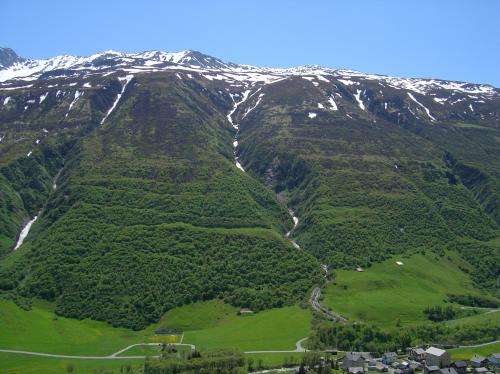Consequences of abandoning Alpine meadows: Observation alone will change nothing

Agriculture is increasingly vanishing from the Alps. Land that was cultivated for centuries is now being abandoned and scrubs are encroaching on it. This affects not only the landscape, but also the water balance and will in future also have an impact on power generation. These are the conclusions reached by an interdisciplinary research group supported by the Swiss National Science Foundation (SNSF).
The Ursern Valley near Andermatt is in many ways a typical high mountain valley in the Alps. The first inhabitants arrived here around 800 years ago and turned patches of forest into open cultivated land where goats, sheep or cows were able to graze. The sustainable alpine farming that followed for hundreds of years is now on the decline. Sixty years ago there were still over 100 farms in the Ursern Valley; now there are only 30 left. Many of the less accessible pastures on the mountain slopes were abandoned and are now densely covered by alder shrubs.
Phenomenal expansion of green alders
In a large-scale Sinergia research project, plant ecologists, soil experts, hydrologists and economists coordinated by Erika Hiltbrunner and led by Christian Körner from the University of Basel have examined the consequences of farms being abandoned in the higher reaches of the Alpine range. In the Ursern Valley, it is mainly the green alder that is spreading like wildfire, 2.5 times as fast as the forest in the Swiss Alpine region. The area covered by the green alders has increased by one-fourth in the last ten years alone. This shrub, which is normally found in stream beds and avalanche paths, has now come to dominate the north-facing slopes. If this continues, the green alder will completely cover its potential habitat in the Ursern Valley by 2045.
In addition, the green alder is a plant that enters into a symbiosis with nitrogen-fixing bacteria in its roots. "The green alder is a nitrogen pump and over-fertilises the area that it covers," says Körner. Where it grows, the biodiversity of plant life decreases. Young conifers are not able to break through the dense undergrowth. "Without human intervention, the forest cannot make a rapid comeback," Körner explains.
A million francs lost
The spread of the green alder affects the quality of water because the shrub contaminates the water with nitrates. It also has an impact on water balance: surfaces covered by green alders or long, ungrazed grass release between ten and twenty percent more moisture into the air than grassland on which animals graze.
The amount of evaporated water cannot be gauged from the discharge of the Reuss River as the precipitation in the form of rain or snow over a given area cannot be measured accurately in the mountains. However, the steadily decreasing summer discharge during the past 40 years corresponds to the increasing rate of evapotranspiration. An extrapolation of the volume of evaporated water for the entire Ursern Valley suggests that power plants will in future lose between six and eleven gigawatt hours of energy corresponding to half a million and one million Swiss francs per year, depending on the weather.
Landscape preservation with Engadine sheep
"Green alder is invasive. The tactic of simply watching it spread has many downsides and is the worst option we can choose," Körner says. In their project, the researchers have tested another – more promising – option: they have led some Engadine sheep up on the affected pastures. "These sheep peel the bark off the green alders and the damaged shrubs subsequently die off because the transportation of sugar from the leaves to the root is blocked or because the root is killed off by parasitic fungi," Körner explains. More sheep of this old, robust breed would be an effective and simple measure to counteract the undesired scrub encroachment in the Alps. However, the economic analysis conducted by the researchers suggests that the added financial value of sustainable land use is not sufficient to keep the arable land open.
More information: Korner, C. et al. VALUrsern Final Report. (2012).
Provided by Swiss National Science Foundation



















